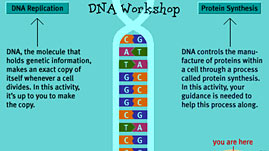When genome researchers announced they had finished sequencing the entire human genome -- all three billion letters of our genetic code -- many considered this feat the ultimate scientific achievement. But as Dr. Eric Lander, one of the scientists instrumental in the genome-sequencing project, said, a sequenced genome is merely half time in this important scientific game.
Lander and other researchers acknowledge that sequencing the entire human genome is a monumental step toward understanding how our bodies work and why they sometimes don't work so well. After all, our DNA is responsible, in major part, for what and who we are. Genetic information contained in the DNA in every one of our cells tells those cells how to behave by dictating which proteins cells should create and when cells should create them. And amazingly, thanks to the process of DNA replication, all of this detailed information can be passed not only from parent to offspring but from "parent cell" to "daughter cell" whenever the parent cell splits.
But if the primary role of DNA is to tell cells which proteins to produce, what then becomes of all those proteins? The nearly infinite and far less known world of proteins is exactly what Lander was referring to when he suggested that genome science was only half the game -- and he may have been exaggerating its contribution at that.
Proteomics, the science of proteins (and the corollary to genome science, or genomics) is still in its infancy. Although this scientific discipline covers a range of topics, from how proteins are synthesized to how they function in the body, one important goal of proteome researchers mirrors that of genome scientists years ago: to catalogue the entire human proteome -- in other words, to create a complete list of all the proteins our species produces.
To give an idea of the magnitude of this task, the human genome contains an estimated thirty thousand genes. Each one of these genes codes for at least one and sometimes many different proteins, and those proteins, in turn, often become modified into many other kinds of proteins. Therefore, the total number of proteins in the human proteome, according to many researchers, will almost surely exceed one million and may be as high as five million. Yet, as difficult as the task of studying proteins is, it is arguably even more important than studying the genome. After all, proteins perform most life functions and make up the majority of cellular structures.


 Loading Standards
Loading Standards Teachers' Domain is proud to be a Pathways portal to the National Science Digital Library.
Teachers' Domain is proud to be a Pathways portal to the National Science Digital Library.
